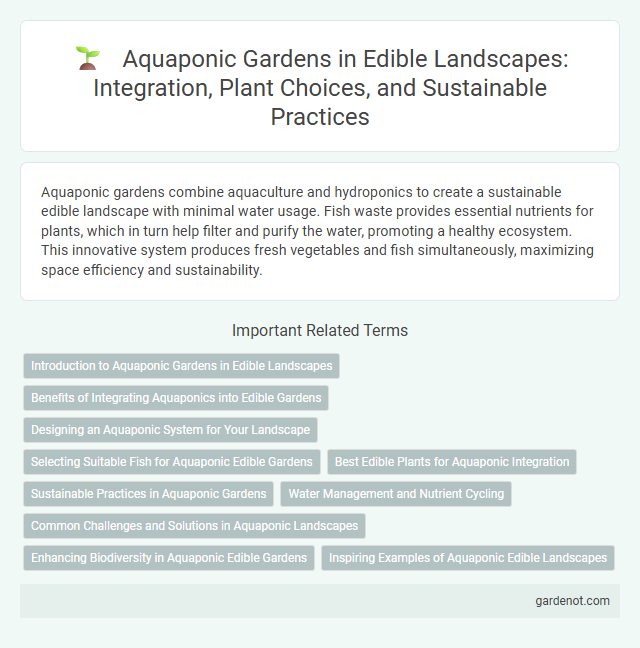Aquaponic gardens combine aquaculture and hydroponics to create a sustainable edible landscape with minimal water usage. Fish waste provides essential nutrients for plants, which in turn help filter and purify the water, promoting a healthy ecosystem. This innovative system produces fresh vegetables and fish simultaneously, maximizing space efficiency and sustainability.
Introduction to Aquaponic Gardens in Edible Landscapes
Aquaponic gardens integrate aquaculture and hydroponics to create a sustainable edible landscape that efficiently recycles water and nutrients. This soil-free system supports the growth of vegetables, herbs, and fish in a symbiotic environment, enhancing food production within limited spaces. By leveraging natural biological cycles, aquaponics reduces reliance on chemical fertilizers and conserves water, making it ideal for urban and drought-prone areas.
Benefits of Integrating Aquaponics into Edible Gardens
Integrating aquaponics into edible gardens enhances sustainability by combining fish farming with hydroponic plant cultivation, resulting in efficient nutrient cycling and water conservation. This symbiotic system increases crop yields and provides fresh fish protein, promoting self-sufficiency and reducing environmental impact. Aquaponic gardens also improve space utilization and enable year-round food production, making them ideal for urban and small-scale agricultural settings.
Designing an Aquaponic System for Your Landscape
Designing an aquaponic system for your edible landscape involves integrating fish tanks and grow beds to create a sustainable nutrient cycle that supports plant growth. Optimal system design considers factors like water circulation, fish species selection, and plant compatibility to maximize yield and resource efficiency. Incorporating native plants and edible crops within this closed-loop environment enhances biodiversity while providing fresh produce year-round.
Selecting Suitable Fish for Aquaponic Edible Gardens
Selecting suitable fish for aquaponic edible gardens involves prioritizing species that thrive in controlled environments and contribute to nutrient-rich water for plants. Tilapia, catfish, and trout are popular choices due to their adaptability, rapid growth, and high protein content, which supports efficient nutrient cycling. Water temperature, oxygen levels, and local regulations also play critical roles in determining the best fish species for sustainable aquaponic systems.
Best Edible Plants for Aquaponic Integration
Lettuce, kale, and spinach thrive in aquaponic gardens due to their rapid growth and nutrient uptake efficiency. Herbs like basil, mint, and cilantro adapt well to aquaponic systems, enhancing flavor profiles and maximizing space utilization. Fruiting plants such as cherry tomatoes and peppers benefit from the balanced nutrient delivery, yielding abundant, healthy crops in aquaponic environments.
Sustainable Practices in Aquaponic Gardens
Aquaponic gardens combine aquaculture and hydroponics to create a sustainable ecosystem that reduces water usage by up to 90% compared to traditional agriculture. Nutrient-rich fish waste serves as a natural fertilizer for plants, eliminating the need for chemical inputs and enhancing soil health when used in edible landscapes. This closed-loop system supports biodiversity and minimizes environmental impact, making it a leading practice in sustainable urban gardening.
Water Management and Nutrient Cycling
Aquaponic gardens efficiently manage water through recirculation systems that reduce waste and conserve resources while supporting plant and fish growth. Nutrient cycling occurs as fish produce waste that is converted by bacteria into essential nutrients, which are then absorbed by plants, creating a sustainable symbiotic ecosystem. This integration optimizes water quality and nutrient availability, enhancing both crop yield and fish health in edible landscapes.
Common Challenges and Solutions in Aquaponic Landscapes
Common challenges in aquaponic gardens include nutrient imbalances, water quality management, and pest control, which can affect plant growth and fish health. Maintaining optimal pH levels between 6.8 and 7.2, regular water testing for ammonia and nitrite, and introducing natural predators like ladybugs help mitigate these issues. Implementing automated monitoring systems and integrating complementary plant species enhances system stability and productivity in edible aquaponic landscapes.
Enhancing Biodiversity in Aquaponic Edible Gardens
Aquaponic edible gardens enhance biodiversity by integrating fish, plants, and beneficial microorganisms in a symbiotic ecosystem, promoting natural pest control and nutrient cycling. Diverse plant species, including leafy greens, herbs, and fruiting plants, support a balanced habitat that attracts pollinators and beneficial insects. This biodiversity improves resilience against diseases and boosts overall productivity in sustainable aquaponic systems.
Inspiring Examples of Aquaponic Edible Landscapes
Aquaponic edible landscapes combine aquaculture and hydroponics to create sustainable, self-sufficient food systems that maximize space and resource efficiency. Notable examples include urban rooftops with integrated fish tanks supporting leafy greens, herbs, and vegetables, demonstrating high-yield production with minimal water use. These inspiring aquaponic gardens showcase innovative designs that promote local food security and biodiversity within city environments.
Aquaponic garden Infographic

 gardenot.com
gardenot.com